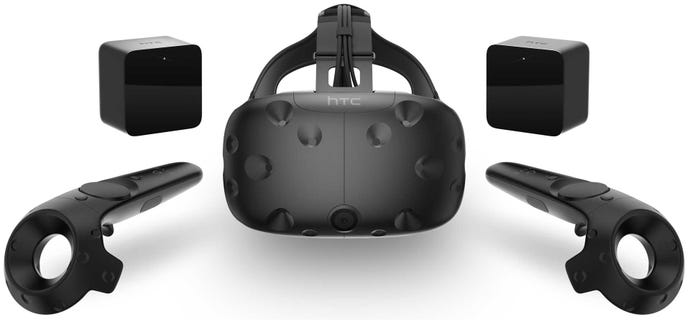HTC Vive VR review: don't believe the hype
The most expensive novelty you'll play with this year. But it's not the future of video games.
"It's such an inelegant solution. The link box and cables drag around your feet as you shuffle within a virtual world. Surely you've not paid $800 to tread on your brand new hardware?"
I don't want to be the record company exec who passed on signing The Beatles. I don't want to be the journalist who said the internet would never catch on. I don't want to be the video game boss who declared consoles dead. I don't want to be that guy.
But Vive VR at this point in time is the most disappointing hardware I've played around with since Kinect. It's overpriced, over complicated and above all there's no good games for it. Like you, I want to see the future of video game entertainment. But this isn't it, not by a long shot.
The first time is amazing. The first time is always amazing, right? When you first strap the headset on and power it all up, and go through a slick-as-hell tutorial that's cute and funny and welcoming, you're given a taste of what VR can be. It's a new world. It's your first holiday without your parents, your first joint, your first gig and the first time you had good sex. It's mind-expanding and you'll feel a little bit more mature afterwards. You're closer to the meaning of life than you were before you started. It's basically Super Mario 64 all over again.
But to be honest the problems start before that, you're just so excited about trying Vive that you put up with the inconvenient set-up. Vive requires a full room space for optimal performance (a sit down/stand still option is available, but that misses the point of the package you've just spent $800 on). It also requires you drill holes in your wall to mount two brackets for the base stations. Or you can use two tripods (who the hell has two tripods?). Plug in three power adapters, another two power adapters to charge the controllers, set up the various cables and link box to the PC, and then three lots of cables to your headset and your own headphones.
It's such an inelegant solution. The link box and cables drag around your feet as you shuffle within a virtual world. Surely you've not paid $800 to tread on your brand new hardware? Product shots make it look slick but the reality is it's got your boot prints all over it after an hour. I know we're not at the stage where a wireless headset is viable, but having a bundle of cables hanging out the back of your head, forever rubbing your shoulder, is not immersive. It's ugly. Who knew that virtual reality in 2016 was actually the same as it was envisioned 20 years ago in cheap sci-fi movies? You need a squire to help you dress and hand you controllers in the dark.
If software sells hardware then by rights the Vive shouldn't be selling at all. There's loads of demos and first episodes of interesting games or experiences, but there's barely any honest-to-goodness games to get stuck into. Valve's The Lab is a great little collection of mini-games and stuff to fiddle around with. The interactive map of the universe is jaw-dropping. It's the best interactive map of the universe I've ever stood in front of. But, you know, not wishing to sound ungrateful, it's just an interactive map of the universe. It reminds me of Reggie Fils-Aime stating the Wii U would be the only all-in-one TV remote you'd ever need. Yeah? It's still a TV remote, Reg.
The quality of the screen resolution bothers me too. I didn't know what this was called at first, but it's the screen-door effect. Those visible geometric shapes really stand out in any static situation. And this is VR, so looking deeply at the intricacies of the world you're in is whole the point. Some say it's not noticeable in a game with action and fast movement, but I find that turns the visuals blurry. In a world of 1080p 60fps TVs and monitors as standard, it's a noticeable step back. Am I being picky? I've read comments from users who describe it as "fine". "How's the future of interactive entertainment, Brian?" "Oh, it's fine." That doesn't really sell it to me. I think it's justified to be picky about everything to do with $800 hardware.
All these tech demos and interactive experiences are interesting and impressive, but they're not games. The mark of a good game is that twitch you get when you're not playing it. Thinking about it, how to improve, how to level, where to go next - when you're away doing something else. I can think of 20 games off the top of my head that have had me hooked in the past couple of years. Vive doesn't have them. There's no killer app.
It's not software that sold this hardware, it's hype. The Valve association goes a long way, and The Lab triggers all those feelings we have for games we love; the return of the Portal robots and other easter eggs is such a tease. Developers themselves have gone crazy for VR in all its forms, you can see it in their eyes. They want to believe it's the VR they were promised as kids. Don't we all? And to be fair, developers can no doubt see a future where this technology advances to fulfill those dreams.
But developers are also used to working on unfinished technology, work-in-progress games, half ideas and buggy code. It's their job. We're starting to get used to that too, as we sign up to early access and play betas, or worse, broken day one releases. Vive VR feels like early access hardware. And this is supposed to be the most high-end solution available right now.
Strapping a lunchbox to my face to see the future of games, apparently.
A photo posted by Matt Martin (@m_spitz) on
Mark Zuckerberg reckons VR won't be mainstream until at least another 10 years' time. And that's coming from the man who paid $2 billion for Oculus. I hope it does go on to be mainstream, affordable tech but it's not there yet. Not now. Not at all.
"Developers are used to working on unfinished technology, work-in-progress games, half ideas and buggy code. It's their job. Vive VR feels like early access hardware."
Vive VR feels like prototype hardware, like mobile phones in the 80s. It's functional and curious but ugly and out of our price range. It's experimental in form, and has the software to match. If you're buying this to experience the future of video games you're going to be disappointed. You're only investing in a possible future for video games. And with all technology iterations, the Vive will be superseded soon enough. Anyone who tries to justify $800 spent on this technology is delusional. I feel sorry for them, they've been sold the emperor's new clothes. It's expensive and the thrills come crashing down after the shortest of time. You'd be insane to spend the asking price and the additional costs of the PC hardware to take part in a clunky novelty that's not nearly as good as everyone wishes it was.
Vive VR allows you to see all around you, but take the headset off and you'll realise you're not missing a thing.






-trailer---Sonic-%26-Knuckles.jpg?width=291&height=164&fit=crop&quality=80&format=jpg&auto=webp)



.jpg?width=291&height=164&fit=crop&quality=80&format=jpg&auto=webp)

.jpeg?width=291&height=164&fit=crop&quality=80&format=jpg&auto=webp)